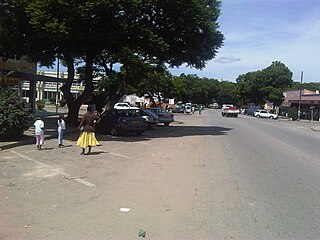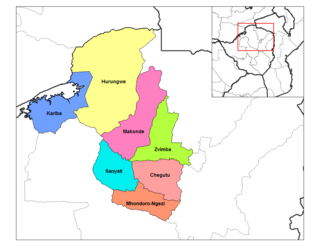
Manicaland is a province in eastern Zimbabwe. After Harare Province, it is the country's second-most populous province, with a population of 2.037 million, as of the 2022 census. After Harare and Bulawayo provinces, Manicaland is Zimbabwe's third-most densely populated province. Manicaland was one of five original provinces established in Southern Rhodesia in the early colonial period. The province endowed with country's major tourist attractions, the likes of Mutarazi Falls, Nyanga National Park and Zimbabwe's top three highest peaks. The province is divided into ten administrative subdivisions of seven rural districts and three towns/councils, including the provincial capital, Mutare. The name Manicaland is derived from one of the province's largest ethnic groups, the Manyika, who originate from the area north of the Manicaland province and as well as western Mozambique, who speak a distinct language called ChiManyika in Shona.

Gweru, originally known as Gwelo, is a city in central Zimbabwe. It is on the centre of Midlands Province. Originally an area known to the Ndebele as "The Steep Place" because of the Gweru River's high banks, in 1894 it became the site of a military outpost established by Leander Starr Jameson. In 1914 it attained municipal status, and in 1971 it became a city.

Rusape is a town in eastern Zimbabwe.
The government of Zimbabwe is the main provider of air, rail and road services; historically, there has been little participation of private investors in transport infrastructure.
Highfield is the second oldest high-density suburb or township in Harare, Zimbabwe built to house Rhodesians of African origin, the first being Mbare. Highfield was founded on what used to be Highfields Farm. It is of historical, cultural and political significance to Zimbabwe and is known as Fiyo in local slang. It is one of the birthplaces of the Zimbabwe African National Union and is home to several prominent people in the country such as Gregy Vambe and Oliver Mtukudzi, and formerly Robert Mugabe.
Shurugwi, originally known as Selukwe, is a small town and administrative centre in Midlands Province, southern Zimbabwe, located about 350 km south of Harare, with a population of 22,900 according to the 2022 census. The town was established in 1899 on the Selukwe Goldfield, which itself was discovered in the early 1890s not long after the annexation of Rhodesia by the Pioneer Column.
Nyazura is the second largest urban settlement in Makoni District in Manicaland Province, Zimbabwe located 72 km north-west of Mutare on the main road and railway linking Harare and Mutare. The settlement is named after the Nyazure River which is a tributary of the Save River. The phosphate from Dorowa are handled by the railways here. The town is located 191km from Harare along the Harare Mutare Highway. It is 20 kilometres from Rusape and 70km from Mutare. The major part of Nyazura is believed to be under the rule of the Rukweza family.
Wedza is a district in the province of Mashonaland East, Zimbabwe. It is located about 50 kilometres (31 mi) south of Marondera, and 127 kilometres (79 mi) south of Harare. The area was sparsely inhabited by the Mbire people of the Soko Clan as early inhabitants who mined iron in the Hwedza hills during the 9th-12th centuries which means "a place of wealth". A village of Wedza was established in 1910 by Colonial administration. Gold, beryl, nickel, tungsten and grayite were mined in the hills around the village but deposits were too small to make further commercial mining viable.
Banket is a town in the province of Mashonaland West, Zimbabwe. It is located about 95 km north-west of Harare on the main Harare-Chinhoyi road. According to the 1982 Population Census, the town had a population of 5,698. The name of the town is derived from banket rock formation: early settlers saw a conglomerate, which they hoped would bear gold, like the banket of the Witwatersrand gold fields. The conglomerate was not gold-bearing, although gold was late discovered and, along with chromite, is still mined in the area. Cattle, maize, cotton and tobacco are commercially farmed in the area.
Murombedzi is a town in Zimbabwe.

Cornway College is a private, co-educational, day and boarding school in Mount Hampden, Mashonaland West, Zimbabwe, which is 16.5 kilometres from the Harare Central Business District. Cornway College was established in 2006 at its present location. It has a preparatory school and a high school. The language of instruction is English.

Chegutu, originally known as Hartley, is a district of Mashonaland West Province, Zimbabwe. The district headquarters is located in Chegutu, a city which lies of the Harare-Bulawayo Road,.

Zvimba District is a district of Mashonaland West Province, Zimbabwe.

Makonde District is a district in Zimbabwe.
Moleli High School, is a co-education high school located in Mashonaland West Province, Makwiro, Chegutu District, Msengezi area near the town of Norton in the Zvimba area, 80 kilometres southwest of the Zimbabwean capital Harare. It offers O' and A' levels in boarding facilities. It was established in 1962 by Ronald E. Sellers of the Methodist Church in Zimbabwe and named after the late Methodist Rev. Modumedi Moleli and is a Methodist mission school. Moleli has a student population of about 620 pupils, and is considered one of Zimbabwe's top performing high schools. It is a sister school to Sandringham High School which they share sibling rivalry.
Kotwa is a small town in Mudzi District, Mashonaland East province, Zimbabwe. It is the capital of the district, serving as its administrative and commercial centre.
Empress Mine Township is a populated place in the area formerly known as Salakuhle in Zhombe Communal Land, Kwekwe District of the Midlands Province in Zimbabwe. It is Zhombe's largest growth point yet officially it is rated second after Zhombe Joel, the current Zhombe District capital.
The A5 Highway is a national road in Zimbabwe. It joins the cities of Harare and Bulawayo, and is hence known as the Harare-Bulawayo Highway. It is one of the two routes that form the R2 Route, which connects Harare with the Plumtree Border with Botswana.
Glen View is a high-density suburb that lies on the border of Harare Province and Mashonaland West. It split between the two provinces, with the larger part on Harare’s side and the remainder on Mashonaland West side under their governance of Zvimba Rural District. It is believed to have 160,000(6.4% of Harare’s population) people although the Zimstat says it has on 45,000 people. It shares boundaries with Budiriro on the North (4.341km), Glen Norah on the East(4.0km), South and West being Mashonaland West. It is divided into 8 parts namely Glen View 1, 2, 3, 4, 7, 8, 1 Extension and Riverside. It has around 15000 residential stands which ranges from 200sqm to 500sqm with most of them averaging 10 people per house.






